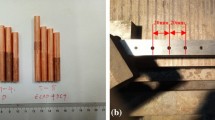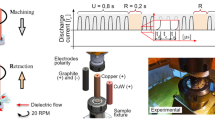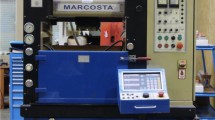Abstract
Tool electrode wear is a severe problem in electrical discharge machining (EDM) which significantly affects the efficiency of the machining process and dimensional accuracy. In this paper, ultra-fine-grained (UFG) structures due to their unique and unusual properties are used to alleviate the wear problem of tool electrode. Equal-channel angular pressing (ECAP) is a novel severe plastic deformation metal forming process which can produce ultra-fine to nanoscale grains in bulk materials. Commercially pure copper was ECAP-ed to produce UFG microstructures and then used as tool electrode in EDM. The performance parameters in the EDM process, which have been studied, are material removal rate (MRR), volumetric electrode wear (VEW) and electrode wear ratio (EWR). For UFG and coarse-grained electrodes, the MRR, VEW and EWR obtained in EDM process have been compared. The results show that VEW and EWR decrease when UFG copper tool electrodes are used. But with increasing machining time, VEW and EWR of UFG copper electrodes approach those of the coarse-grained copper electrode.








Similar content being viewed by others
References
Rajurkar K P, Sundaram M M, and Malshe A P, Proc CIRP 6 (2013) 13.
VinothKumar S, and PradeepKumar M, Trans Indian Inst Met 70 (2017) 2293.
Liu C C, Mater Sci Eng A 363 (2003) 221.
Schumacher B M, J Mater Process Technol 149 (2004) 376.
Guu Y H, Hocheng H, Chou C Y, and Deng C S, Mater Sci Eng A 358 (2003) 37.
Yang X, Guo J, Chen X, and Kunieda M, Precis Eng 35 (2011) 51.
Tsai H C, Yan B H, and Huang F Y, Int J Mach Tools Manuf 43 (2003) 245.
Monzon M, Benítez A N, Marrero M D, Hernandez N, Hernandez P, and Aisa J, J Mater Process Technol 196 (2008) 109.
Lonardo P M, and Bruzzone AA, CIRP Ann 48 (1999) 123.
Ozgedik A, and Cogun C, Int J Adv Manuf Technol 27 (2006) 488
Song K Y, Park M S, and Chu C N, Precis Eng 37 (2013) 738.
Srivastava V, and Pandey P M, J Manuf Process 15 (2013) 158.
Uhlmann E, and Roehner M, CIRP J Manuf Sci Technol 1 (2008) 92
Khanra A K, Pathak L C, and Godkhindi M M, Bull Mater Sci 32 (2009) 401.
Li L, Wong Y S, Fuh J Y, and Lu L, Mater Des 22 (2001) 669
Khanra A K, Sarkar B R, Bhattacharya B, Pathak L C, and Godkhindi M M, J Mater Process Technol 183 (2007) 122.
Wang J, Wei W, Huang X, Li L, and Pan F, Mater Sci Eng A 529 (2011) 497.
Heidari S, Bakhshan Y, Khorshidi Mal Ahmadi J, and Afsari A, Modares Mech Eng 19 (2019) 1187
Higuera-Cobos O F, and Cabrera J M, Mater Sci Eng A 571 (2013) 103.
Reihanian M, Ebrahimi R, Tsuji N, and Moshksar M M, Mater Sci Eng A 473 (2008) 189.
Jayakumar P K, Balasubramanian K, and Tagore G R, Mater Sci Eng A 538 (2012) 7.
Hosseini S A, and Manesh H D, Mater Des 30 (2009) 2911.
Zhilyaev A P, Shakhova I, Belyakov A, Kaibyshev R, and Langdon T G, Wear 305 (2013) 89
Kumar S R, Gudimetla K, Mohanlal S, and Ravisankar B, Trans Indian Inst Met 72 (2019) 1437.
Keshtiban P M, Behnagh R A, and Alimirzaloo V, Trans Indian Inst Met 71 (2018) 659.
Suo T, Li Y, Deng Q, and Liu Y, Mater Sci Eng A 466 (2007) 166.
Habib S S, Appl Math Model 33 (2009) 4397.
Jahan M P, Wong Y S, and Rahman M, J Mater Process Technol 209 (2009) 3956.
Samuel M P, and Philip P K, Int J Mach Tools Manuf 37 (1997) 1625.
Singh S, Maheshwari S, and Pandey P C, J Mater Process Technol 149 (2004) 272.
Acknowledgements
The authors would like to acknowledge the financial support of the “Iranian Nanotechnology Initiative” in Iran.
Author information
Authors and Affiliations
Corresponding author
Additional information
Publisher's Note
Springer Nature remains neutral with regard to jurisdictional claims in published maps and institutional affiliations.
Rights and permissions
About this article
Cite this article
Heidari, S., Afsari, A. & Ranaei, M.A. Increasing Wear Resistance of Copper Electrode in Electrical Discharge Machining by Using Ultra-Fine-Grained Structure. Trans Indian Inst Met 73, 2901–2910 (2020). https://doi.org/10.1007/s12666-020-02091-8
Received:
Accepted:
Published:
Issue Date:
DOI: https://doi.org/10.1007/s12666-020-02091-8




